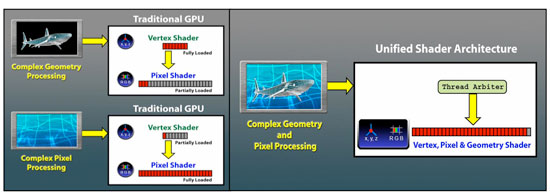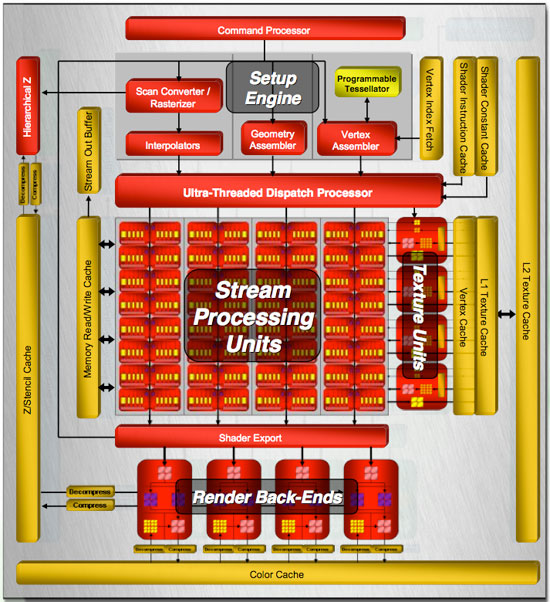ATI Radeon HD 2900 XT: Calling a Spade a Spade
by Derek Wilson on May 14, 2007 12:04 PM EST- Posted in
- GPUs
R600 Overview
From a very high level, we have the same capabilities we saw in the G80, where each step in the pipeline runs on the same hardware. There are a lot of similarities when stepping way back, as the same goals need to be accomplished: data comes into the GPU, gets setup for processing, shader code runs on the data, and the result either heads back up for another pass through the shaders or moves on to be rendered out to the framebuffer.

The obvious points are that R600 is a unified architecture that supports DX10. The set of requirements for DX10 are very firm this time around, so we won't see any variations in feature support on a basic level. AMD and NVIDIA are free to go beyond the DX10 spec, but these features might not be exposed through the Microsoft API without a little tweaking. AMD includes one such feature, a tessellator unit, which we'll talk about more later. For now, let's take a look at the overall layout of R600.

Our first look shows a huge amount of stream processing power: 320 SPs all told. These are a little different than NVIDIA's SPs, and over the next few pages we'll talk about why. Rather than a small number of SPs spread across eight groups, our block diagram shows R600 has a high number of SPs in each of four groups. Each of these four groups is connected to its own texture unit, while they share a connection to shader export hardware and a local read/write cache.
All of this is built on an 80nm TSMC process and uses in the neighborhood of 720 Million transistors. All other R6xx parts will be built on a 65nm processes with many fewer transistors, making them much smaller and more power efficient. Core clock speed is on the order of 740MHz for R600 with memory running at 825MHz.
Memory is slower this time around with higher bandwidth, as R600 implements a 512-bit memory bus. While we're speaking about memory, AMD has revised their Ring Bus architecture for this round, which we'll delve into later. Unfortunately we won't be able to really compare it to NVIDIA's implementation, as they won't go into any detail with us on internal memory buses.
And speaking of things NVIDIA won't go into detail on, AMD was good enough to share very low level details, including information on cache sizes and shader hardware implementation. We will be very happy to spend time talking about this, and hopefully AMD will inspire NVIDIA to start opening up a little more and going deeper into their underlying architecture.
To hit the other hot points, R600 does have some rather interesting unique features to back it up. Aside from including a tessellation unit, they have also included an audio processor on their hardware. This will accept audio streams and send them out over their DVI port through a special converter to integrate audio with a video stream over HDMI. This is unique, as current HDMI converters only work with video. AMD also included a programmable AA resolve feature that allows their driver team to create new ways of filtering subsample data.
R600 also features an independent DMA engine that can handle moving and managing all memory to and from the GPU, whether it's over the PCIe bus or local memory channels. This combined with huge amounts of memory bandwidth should really assist applications that require large amounts of data. With DX10 supporting up to 8k x 8k textures, we are very interested in seeing these limits pushed in future games.
That's enough of a general description to whet your appetite: let's dig down under the surface and find out what makes this thing tick.










86 Comments
View All Comments
yyrkoon - Tuesday, May 15, 2007 - link
See, the problem here is: guys like you are so bent on saving that little bit of money, by buying a lesser brand name, that you do not even take the time to research your hardware. USe newegg , and read the user reviews, and if that is not enough for you, go to the countless other resources all over the internet.yyrkoon - Tuesday, May 15, 2007 - link
Blame the crappy OEM you bought the card from, not nVIdia. Get an EVGA card, and embrace a completely different aspect on video card life.MSI may make some decent motherboards, but their other components have serious issues.
LoneWolf15 - Thursday, May 17, 2007 - link
Um, since 95% of nvidia-GPU cards on the market are the reference design, I'd say your argument here is shaky at best. EVGA and MSI both use the reference design, and it's even possible that cards with the same GPU came off the same production line at the same plant.DerekWilson - Thursday, May 17, 2007 - link
it is true that the majority of parts are based on reference designs, but that doesn't mean they all come from the same place. I'm sure some of them do, but to say that all of these guys just buy completed boards and put their name on them all the time is selling them a little short.at the same time, the whole argument of which manufacturer builds the better board on a board component level isn't something we can really answer.
what we would suggest is that its better to buy from OEMs who have good customer service and long extensive warranties. this way, even if things do go wrong, there is some recourse for customers who get bad boards or have bad experiences with drivers and software.
cmdrdredd - Monday, May 14, 2007 - link
you're wrong. 99% of people buying these high end cards are gaming. Those gamers demand and deserve the best possible performance. If a card that uses MORE power and costs MORE (x2900xt vs 8800gts) and performs generally the same or slower what is the point? Fact is...ATI's high end is in fact slower than mid range offerings from Nvidia and consumes alot more power. Regardless of what you think, people are buying these based on performance benchmarks in 99% of all cases.AnnonymousCoward - Tuesday, May 15, 2007 - link
No, you're wrong. Did you overlook the emphasis he put on "NOT ALWAYS"?You said 99% use for gaming--so there's 1%. Out of the gamers, many really want LCD scaling to work, so that games aren't stretched horribly on widescreen monitors. Some gamers would also like TVout to work.
So he was right: faster is NOT ALWAYS better.
erwos - Monday, May 14, 2007 - link
It'd be nice to get the scoop on the video decode acceleration present on these boards, and how it stocks up to the (excellent) PureVideo HD found in the 8600 series.imaheadcase - Tuesday, May 15, 2007 - link
I agree! They need to do a whole article on video acceleration on a range of cards and show the pluses and cons of each card in respective areas. A lot of people like myself like to watch videos and game on cards, but like the option open to use the advanced video features.Turnip - Monday, May 14, 2007 - link
"We certainly hope we won't see a repeat of the R600 launch when Barcelona and Agena take on Core 2 Duo/Quad in a few months...."Why, that's exactly what I had been thinking :)
Phew! I made it through the whole thing though, I even read all of those awfully big words and everything! :)
Thanks guys, another top review :)
Kougar - Monday, May 14, 2007 - link
First, great article! I will be going back to reread the very indepth analysis of the hardware and features, something that keeps me a avid Anandtech reader. :)Since it was mentioned that overclocking will be included in a future article, I would like to suggest that if possible watercooling be factored into it. So far one review site has already done a watercooled test with a low-end watercooling setup, and without mods acheived 930MHz on the Core, which indirectly means 930MHz shaders if I understand the hardware.
I'm sure I am not the only reader extremely interested to see if all R600 needs is a ~900-950MHz overclock to offer some solid GTX level performance... or if it would even help at all. Again thanks for the consideration, and the great article! Now off to find some Folding@Home numbers...